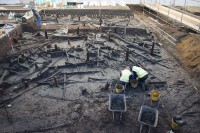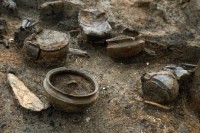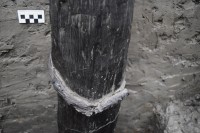 Must Farm quarry in the Cambridgeshire fens near Whittlesey, southeast England, is the site of a Late Bronze Age pile-dwelling settlement so well-preserved that it the press gleefully dubbed it the Pompeii of the Fens. Like all of the myriad “Pompeii of the X” out monickers out there, it’s an entirely inaccurate comparison, but the site is unprecedented on its own terms. The excavation of the 3,000-year-old settlement unearthed the largest group of Bronze Age artifacts ever found in Britain, and that was just the beginning. Beyond the thousands of objects — textiles, beads of amber, jet and glass, fineware and coarseware pottery,
Must Farm quarry in the Cambridgeshire fens near Whittlesey, southeast England, is the site of a Late Bronze Age pile-dwelling settlement so well-preserved that it the press gleefully dubbed it the Pompeii of the Fens. Like all of the myriad “Pompeii of the X” out monickers out there, it’s an entirely inaccurate comparison, but the site is unprecedented on its own terms. The excavation of the 3,000-year-old settlement unearthed the largest group of Bronze Age artifacts ever found in Britain, and that was just the beginning. Beyond the thousands of objects — textiles, beads of amber, jet and glass, fineware and coarseware pottery,  spear points, a bronze sickle or bill hook, swords, tools, weirs, eel traps, a wooden bowl with the remains of nettle stew, eight intact log boats, an absolutely incredible intact wooden wheel, and much more — the structure of the settlement itself was revealed in the remains of collapsed roundhouses built on stilts, complete with wattle walls, a large wooden platform and a wooden palisade.
spear points, a bronze sickle or bill hook, swords, tools, weirs, eel traps, a wooden bowl with the remains of nettle stew, eight intact log boats, an absolutely incredible intact wooden wheel, and much more — the structure of the settlement itself was revealed in the remains of collapsed roundhouses built on stilts, complete with wattle walls, a large wooden platform and a wooden palisade.
Organic materials were exquisitely preserved in the waterlogged river-silt of what is now the Flag Fen Basin, making the Must Farm settlement the site of the most completely preserved prehistoric domestic structures in Britain. Only the Neolithic lake-dwellings of the Circum-Alpine can compare with Must Farms’ diversity of artifacts, surviving architecture and clear definition of how the settlement was organized.
When excavations ended in 2016, archaeologists had a rough idea of the settlement’s timeline based on their field work. The first stages of construction took place around 1300 B.C. in the channel of the ancient Nene River. This was not a settlement, but a causeway used to cross the channel and for fishing. As groundwater levels rose, the causeway was flooded and in around 1000 B.C. new piles were sunk and the palisade added to help keep water out. Then, between 920 and 800 B.C., the settlement was struck by a catastrophic fire which put an end to human habitation of the site.
In the first publication since the end of excavations, archaeologists from the Cambridge Archaeological Unit present a new, much shorter window of time in which Must Farm was occupied before its destruction by fire.
 The oak piles discovered in a 2006 archaeological survey of the site pre-date the pile-dwelling settlement. They were the supports for a causeway across the southeastern end of the Flag Fen Basin. By the time the settlement was built, all that would have been visible of the causeway were the rotted tops of the oak piles showing above the water.
The oak piles discovered in a 2006 archaeological survey of the site pre-date the pile-dwelling settlement. They were the supports for a causeway across the southeastern end of the Flag Fen Basin. By the time the settlement was built, all that would have been visible of the causeway were the rotted tops of the oak piles showing above the water.
 The pile-dwellings were constructed during a period when the river, still active, was shallow and wide from silt build-up. The settlement consisted of at least five buildings on stilts, four circular, one trapezoidal, a palisade and a raised walkway. They were built over deep-set concentric rings of piles strong enough to support heavy roof timbers. The floors were relatively lightweight, built using slim poles and hurdle panels. Pathways of mortis-jointed timbers connected the structures and lined the inside of the palisade.
The pile-dwellings were constructed during a period when the river, still active, was shallow and wide from silt build-up. The settlement consisted of at least five buildings on stilts, four circular, one trapezoidal, a palisade and a raised walkway. They were built over deep-set concentric rings of piles strong enough to support heavy roof timbers. The floors were relatively lightweight, built using slim poles and hurdle panels. Pathways of mortis-jointed timbers connected the structures and lined the inside of the palisade.
The thin stratigraphy, architectural clarity and highly structured artefactual and biological assemblages all suggest a brief occupation. The settlement’s limited life span is most vividly expressed by the close stratigraphic relationship between the woodchips from construction and the collapsed, charred structural remains of its demise, with the latter resting more or less directly on top of the former.
The emerging evidence suggests that one year is a reasonable estimate for the length of settlement occupation. Ongoing dendrochronological analysis of the structural timbers reveals that the settlement was built in a single construction phase, using wood of a similar felling year. The same analysis also shows differential sapwood shrinkage on areas of individual oaks protected from, and exposed to, the fire, which suggests that the timbers were still green, or unseasoned, when the settlement was destroyed by fire. Oak timber is broadly accepted to require one to two years to season under natural conditions in Britain. This would provide a terminus ante quem for the duration of occupation, if confirmed by experimental charring of green oak. During excavation, it also became clear that wood-boring insect damage was nearly absent on the structural timbers, despite the retention of sapwood and bark on many elements, including the hurdle gangway. Insects are known to colonise timber structures rapidly; this includes synanthropes, which are also absent in the Must Farm assemblage.
So instead of decades of occupation, it seems the settlement was active for less than a year when disaster struck. The density of artifacts, some of which could not have been locally sourced and must have come from impressively extended trade networks, in dwellings that were only occupied for a matter of months attest to the remarkable richness of daily life in an entirely routine Bronze Age fenland settlement.
The study is fascinating and exceptionally readable and has been published in open access form so everyone can enjoy its contents free of charge. I highly recommend it.